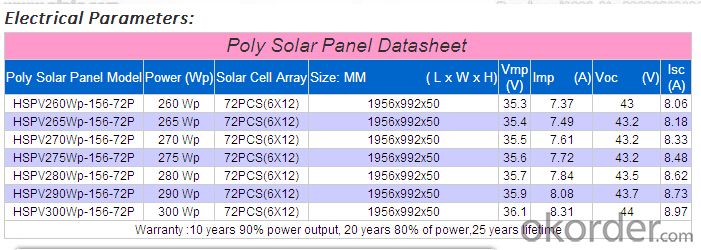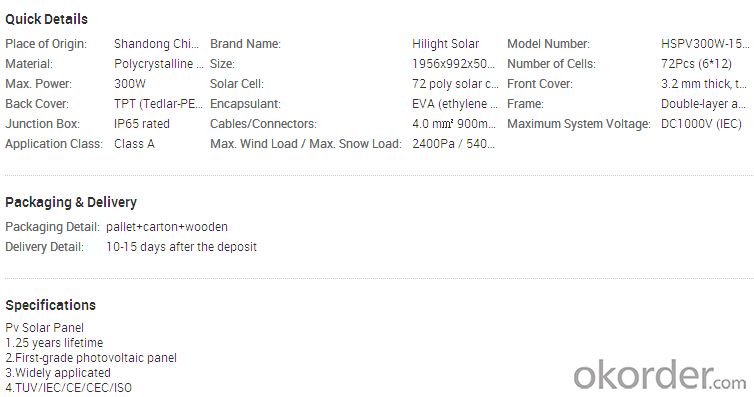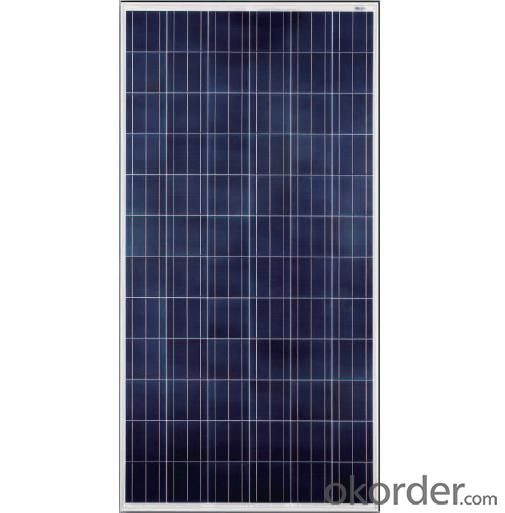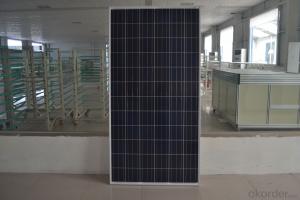Polycrystal Solar Panel HSPV270WP-156-72P
- Loading Port:
- Qingdao
- Payment Terms:
- TT OR LC
- Min Order Qty:
- 300 watt
- Supply Capability:
- 3000 watt/month
OKorder Service Pledge
OKorder Financial Service
You Might Also Like
HSPV265WP-156-72P
※ High efficiency crystalline silicon cells.
※ High transmission low iron tempered glass, strong mechanical resistance.
※ Standard waterproof junction box, with bypass diode.
※ High endurance to different atrocious weather
※ IEC 61215 and IEC61730 Class A certificates
※ Conformity to CE.
※ Applicable to residential roof top systems, On-grid/Off-grid utility, commercial system.
※ 10-year quality guarantee and 10 - 25-year power output guarantee.



FAQ
1.Can you offer the test report of the module?
A:Sure. All the solar modules must pass necessary tests including EL test and ultra-red test and other visual test of the appearance, and the test report presents all the detailed data of the modules.
2. How to confirm about the quantity and the type of solar module?
A:It depends on the solar system where you want to put into use the solar modules. We have experienced engineers to design for your order and you need to give more information to fix the details.
- Q:How do I clean my solar panels?
- To clean your solar panels, start by turning off the system and ensuring the panels are cool to touch. Use a soft brush or sponge with mild detergent mixed in water to gently scrub away any debris or dirt. Rinse the panels with clean water and allow them to dry naturally. Avoid using abrasive materials or harsh chemicals, as they may damage the panels. Additionally, be cautious when working at heights and consider seeking professional help if needed.
- Q:I can't figure out how to charge a Ni Cd (BD 8V Firestorm) battery directly with a solar panel so I've come up with an alternative which might or might not work. I thought I would connect an inverter (I found a nice 400W for $30) to my trucks battery and plug the BD Firestorm battery charger into the inverter. Then I was thinking I could use a 5W solar panel to trickle charge the truck battery and keep it connected after the Ni Cd is charged to ensure the truck battery is topped off. The truck would not be running during this process. Will this solution work? Is there a better solution?
- Two of those solar panels connected in series will easily charge a 8V battery. I would not even be concerned about over voltage the solar cells will have plenty of internal resistance.
- Q:How much does 000 square feet of solar panels cost? This is for a pool with dimensions 75ft by 25ft? How much will it cost including installation fee and the water heater?
- My Father-in-Law had around 300sqft of solar panels installed for the equivalent of around ?3000 or $5000. These were just the cheap and relatively inefficient black plastic tubes that were installed on his roof. This was in South Africa where the labour rates are quite cheap. The system works okay and heats a 40ft x 20ft outdoor pool to over 30C in the height of summer. Rather than a pool heater, I think it might be good to look at an air source heat pump to help heat the water in Autumn/Winter when you don't get enough sun to heat the pool. These will be expensive (over $5000), but they will use less than 30% of the electricity of a standard electric water heater. Just the solar panels could cost you $5-20K including fitting.
- Q:Is there a material that is capable of absorbing enough UV radiation to make it worth using as a flexible solar cell?Not flexible as in aluminum, but a material such as plastic (polycarbonate).
- Homemade okorder /
- Q:How do solar panels affect the overall carbon footprint of a building?
- Solar panels can significantly reduce the overall carbon footprint of a building. By harnessing clean and renewable energy from the sun, solar panels eliminate or greatly reduce the need for traditional fossil fuel-based electricity generation. This means lower emissions of greenhouse gases like carbon dioxide, which are major contributors to climate change. The use of solar panels helps to transition buildings towards a more sustainable and eco-friendly energy source, effectively reducing their carbon footprint.
- Q:Why can't they put solar-panels on the blades and sides of the 300-500 foot tall turbines? Wouldn't this increase effeciency? Therefore, boosting pay-back time, profits, energy-output?
- No. The solar panels would never be balanced. Those blades need to be very balanced. Additionally, how would the solar panels get the power from a rotating blade to the ground? It is better to have separate units. What we ought to be concerned with is having large solar panel farms. These are counter-productive to going green, as they still require long and harmful power transmission lines. Solar panels ought to be put on top of buildings which would be using that power. Any additional power not used could be added to the power grid. For those types of clean energy that are not practical on the roof might get space near the building, keeping the transmission lines as short as possible. Large farms ought to be owned by the nation, keeping the cost of the power to the customer as low as possible. Power companies rip off consumers with their price gouging. It is time to let the burden of making a few rich at the expense of the many end.
- Q:Do they really save energy? Cut or almost eliminate your electricity bill, if so, how much?Do they have a reserve unit to save electricity that I don't use, to use when the sun is not out?Can it produce enough electricity to cool a house and keep lights and appliances runningLastly, how much are the panels are running for.
- In California, if a house is now connected to the grid, typically, they stay connected to the grid even after installing solar electric panels. In this way, no batteries are required to run at night or over cloudy periods. And the house gets credit for energy generated in excess of usage. This scheme also means that you can size your array to only generate a portion of your electrical usage, which is also the usual decision. Since you mention cooling, an air conditioner is a big power drain. We have no A/C, so a modest 3 kW array is enough to supply all our electrical needs. If we had central air conditioning, that number might be doubled or tripled. Your best bet is to contact a local solar installer to do an analysis and quote on your house. How much it costs, and whether you actually will save money in the long run, depends on where you live, and how much electricity you use. Our system cost $2,000 after all rebates and credits.
- Q:I am doing a science fair project on solar panels, and I need four solar panels to conduct the experiment. I would only need the solar panels for a week. What type of solar panel should I get?
- Your USB power booster may be fragile and is likely expensive, so possibly you should get your 5 volts some other way. 3.7 volts plus a .2 volts D cell is 4.9 volts which is likely close enough for charging most anything with a USB charging cable. If bright sunlight is falling on your solar panel the battery voltage will go to about 5. volts charging at 700 MA, which is also likely acceptable, and will generally be less as part of the 700 ma is being used to charge something else. Also 300 ma may be more typical output of your solar panel even when the sun looks like it is bright. Over charging is unlikely unless the lithium cell has a lower amp-hour = AH rating than the Ni-cad (or nickel metal hydride NiMH 4 AH) D cell, but perhaps you should disconnect the solar panel, if it has been more than one bright sunny day since you charged something with a USB cable. If your battery reads over 5 volts with the solar panel unlighted or disconnected, you are likely to over charge either the lithium cell or the D cell. The PCB protected may complicate adding the D cell (probably not) so you may want to follow your original plan. Your solar panel may send as much as 9 volts to your PCB protection board, when the lithium cell does not need charging: Can the protection board tolerate 9 volts? Probably. If in doubt you can put either a .5 volt or .2 volt rechargeable D cell in series with the solar panel which reduces the input to your PCB protection by about .5 volts. That D cell will over charge, unless you replace it weekly, perhaps oftener. I think your PCB protection prevents over charging and cuts off the load if the lithium cell is discharged to an unsafe level or the load is demanding excessive current. Only the last is a possible problem = one of your USB cords may demand an amount of current that the PCB protection considers excessive. Your USB booster needs about twice as much current as the usb cord is supplying. You don't get the extra voltage by magic. Neil
- Q:What is the average annual energy output of solar panels that can be installed on the home?
- The output of a solar panel would depend on your location and panel size. Most solar panels are rated using 000 Watts per square metre from the sun. This is only possible at the equator. Some supplier have online estimators for output depending on your location. Solar panels rate up to about 250 Watts per panel. I have an online calculator to work out the costs and benefits of solar. You can compare the costs of solar setup and 25 years of electricity versus buying from the grid.
- Q:if i have a 0 Watt solar panel what does that mean. does that mean it will charge a battery 0 watts per hour? Lets say i hook this up to a car battery and use the car battery to run computer stuff. How much will this charge the battery?
- Create okorder /
1. Manufacturer Overview |
|
|---|---|
| Location | |
| Year Established | |
| Annual Output Value | |
| Main Markets | |
| Company Certifications | |
2. Manufacturer Certificates |
|
|---|---|
| a) Certification Name | |
| Range | |
| Reference | |
| Validity Period | |
3. Manufacturer Capability |
|
|---|---|
| a)Trade Capacity | |
| Nearest Port | |
| Export Percentage | |
| No.of Employees in Trade Department | |
| Language Spoken: | |
| b)Factory Information | |
| Factory Size: | |
| No. of Production Lines | |
| Contract Manufacturing | |
| Product Price Range | |
Send your message to us
Polycrystal Solar Panel HSPV270WP-156-72P
- Loading Port:
- Qingdao
- Payment Terms:
- TT OR LC
- Min Order Qty:
- 300 watt
- Supply Capability:
- 3000 watt/month
OKorder Service Pledge
OKorder Financial Service
Similar products
New products
Hot products




























